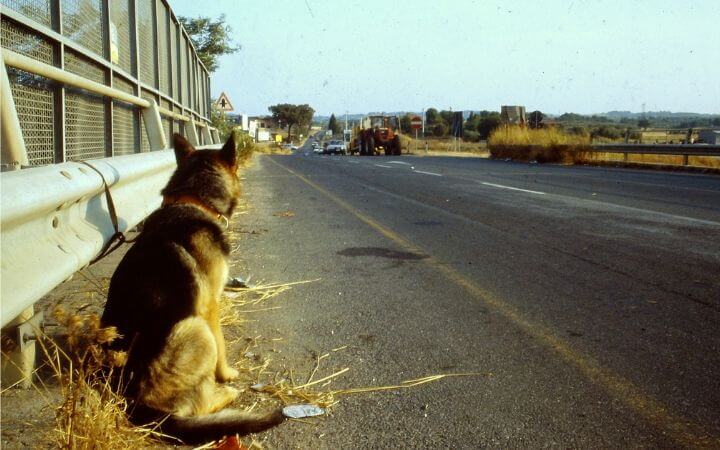In addition to being abhorrent in itself, animal cruelty often leads to violence against adults and children.
In the event that you witness abuse, neglect, or cruelty to an animal, it is your moral responsibility to inform local law enforcement or the local cruelty investigation team.

Doing nothing does nothing to help animals in need. If you fear reprisal, you may do so anonymously.
Please do not ask us for advice about animal cruelty or abuse in the comments section. You should contact your local police department and/or humane society even if you don’t know if the behavior you observe qualifies as animal cruelty since laws vary from state to state. DO NOT ASK US WHAT TO DO; TAKE LEGAL

ACTION! 1 – POOR BODY CONDITION AND NOTICEABLE TRAUMA
The animal has severe matting and a filthy coat, open sores or obvious wounds. He appears to be flea or tick infested. He is underweight and has visible bones. It is obvious he is in physical distress and in need of veterinary care since he may limp or not be able to walk. He may have congested eyes or ears.
2 – LACK OF FOOD OR WATER
It is apparent that she has no visible sources of food and/or water. She is likely to act aggressive due to hunger and thirst, as well as being lethargic from lack of food.
3 – LACK OF SHELTER
Many states have laws that allow owners to be charged if an animal dies after being left alone in a hot car because it is exposed to extreme weather conditions or constant sunlight. Check your state’s laws.
4 – LACK OF SANITATION
Animals’ living areas are covered with debris and/or feces.
5 – ABANDONED
Frequently, companion animals are abandoned and left in vacant buildings or houses which appear empty or devoid of normal human activity.
It is a crime in all 50 states to abandon an animal.
You should be extra vigilant if you notice a neighbor has moved or stopped visiting a residence where you know animals live. Some dogs bark and whine when they are left alone to express their anxiety, but a dog who barks or howls for several hours signals that it needs immediate, lifesaving assistance.

6 – THE ANIMAL IS TIED OR CAGED
It is difficult for her to stand or turn and there is no room for her to move.
7 – CHAINS OR PADLOCKS AROUND THE ANIMAL’S NECK
Animals that have been chained are abused animals. Look out for anything around their necks that may have become embedded and/or infected.
Chaining or tethering is illegal in many states.
8 – SIGNS OF AN ANIMAL BEING TRAINED TO OR HAVING BEEN USED TO FIGHT
In particular, bully breed dogs, and even roosters, are prone to this problem. It is common to see training aids, treadmills, spring poles, and even missing body parts.
9 – THE ANIMAL’S BEHAVIOR IS ABNORMAL
In addition to being very aggressive, she may also be extremely shy, e.g., cowering, hiding, and biting out of fear, even when her owner is present.
10 – TOO MANY ANIMALS LIVING ON ONE PROPERTY
According to estimates, 250,000 animals are hoarding victims each year, which makes these conditions no less cruel.
11 – OVERT ACTS OF VIOLENCE
Anyone who physically abuses an animal, strikes or throws objects at it, or otherwise behaves violently toward it.
Those who abuse animals in public or plain sight are likely doing much worse behind closed doors. Violence against an animal is never justified.
When you witness or suspect animal cruelty or neglect, the worst thing you can do is nothing. Take action and get the animal out of his abusive situation as soon as possible. Make multiple reports if necessary.
FOUR STEPS TO HELP AN ANIMAL WHO IS A CRUELTY VICTIM
A report of alleged animal cruelty must be investigated by the responding agency if it is reported. In most states, animal cruelty is a felony.
It is your responsibility to speak for an animal in distress if you see it in distress. Animals cannot speak for themselves; it is your responsibility to speak for them.

1 – BE PREPARED
In most municipalities, cruelty investigations are conducted by local animal control departments, shelters, or humane societies.
You can always report abuse if you program the number of the agency in your mobile phone when you search online for the one in your area.
2 – SPEAK UP OR CALL 911
Call 911 if you feel unsafe intervening directly in a situation involving overt violence against animals.
If you are traveling or in an unfamiliar community, you can look up the local police department if violence is involved since it is likely part of an ongoing pattern that may include aggression towards people.
3 – DOCUMENT THE DETAILS
Make sure you describe the people and animals involved as accurately as possible. Include the location, date, and time.
Photographs and videos, even from a mobile phone, can be useful for legal purposes. List any witnesses. Remain on the scene until the authorities arrive if possible.
4 – PREPARE TO TESTIFY
It is crucial to have a human witness in order to build a strong, prosecutable case, even if you wish to remain anonymous.





